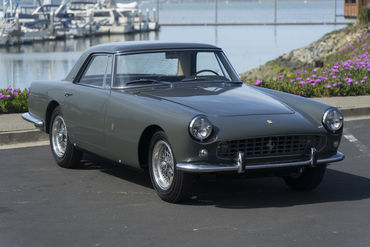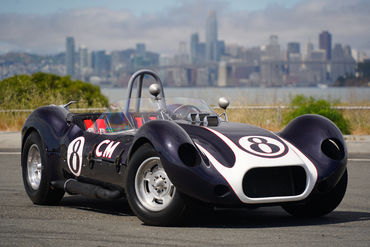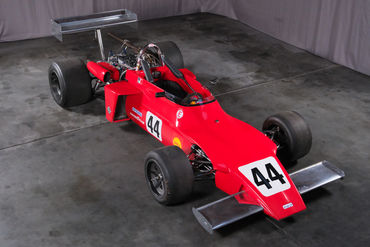Sold
SOLD 02/20
1960 Lotus
19 "Monte Carlo" 2.5L Climax
One of Seven Lotus 19 Chassis Supplied with the Desirable 2.5L Climax. Delivered New to Lotus Formula One Hopeful Peter Ryan.
- VINMK19-959
- Exterior ColorOld English White with Green Stripes
- Interior ColorBlack
- MileageTMU
- Engine2.5 Litre 4-Cylinder Coventry Climax
- Engine no.FPF 1221
- TransmissionHewland FT-200 5-Speed
- StatusSold
- StockFJ1112
Description
1960 Lotus 19 2.5L Climax “Monte Carlo”
s/n MK19-959, Engine no. FPF 1221
Old English white with Green Stripes
With its low-profile twin-cam Coventry Climax mid-engine, lightening quick performance, and unprecedented handling, the Lotus 19 “Monte Carlo” consistently greeted the checkered flag in race after race. The bold design and sparse material construction declared the Chapman philosophy “Add lightness” ensuring durability, performance, and reliability. The lightweight fiberglass body panels were mounted over the specially constructed triangulated frame, which acted as a solid but flexible unified chassis, all combined to make the new Lotus 19 a significant advancement in contemporary motorsports racing.
The Lotus 19 utilized much of the same suspension, braking, and Climax power plant successfully campaigned in the Lotus 18 Formula I and Formula II package, but with a closed wheel sports racing body and chassis package. And while the majority of the 19s were built with small displacement engines, a handful of them were equipped by Lotus with the desirable 2.5L Coventry Climax FPF series DOHC inline four-cylinder engine. These engines had quite simply revolutionized Grand Prix racing, winning five of eight races during the 1959 season, and eight of ten races in 1960. The ground-breaking engine would certainly have been enough to make a formidable competitor, but the Lotus 19 also featured the innovative, Lotus built “Queerbox” transaxle. Although this transaxle boasted a sequential shift pattern and the possibility for ratio changes in under ten minutes, it was initially plagued with reliability issues. Thankfully by the time the 19 was offered, the design was refined such that this small lightweight racing gearbox would prove to be the perfect combination for the Climax engine and the Lotus 19 package.
At the introduction of the Lotus 19, Chapman aptly named the car the “Monte Carlo” in honor of Sir Stirling Moss’s win at the 1960 Monoco Grand Prix, Lotus’s first F1 victory; an appropriate if not a bit intentional jab at the competition, the Cooper Monaco, which had previously been victorious in the same race two years earlier. And while technical merit and past victories are no assurance of future success, when the Lotus 19 arrived at Riverside Raceway in 1960 it literally ushered in a new era for sports car racing. Sir Stirling Moss and Dan Gurney set about their business, obliterating existing track records, with Gurney vaulting the record by over four seconds. Moss too had eclipsed the Silverstone track record in early 1960 by 1.5 seconds, just 36 days after his horrific shunt at Spa. He was still nursing two broken legs and a fractured back, but “was in good spirits after posting the time.” Moss would later go on to win with the 19 at its first official race meeting in Karlskoga, Sweden in August of 1960.
Back in the United States, after mechanical difficulties had sidelined him while leading at Riverside, Moss went on to win both heats of the First Pacific races at Laguna Seca in October of 1960. Gurney went on to win at Nassau in December of 1960, finishing out an incredible first year for Lotus’ new sports racing chassis.
Largely devoted to specialized racecar construction, Lotus would build only limited numbers of each series and thus, because of the rapidly changing technology of the times, production of the Lotus 19 was low, even as customers jockeyed for the opportunity to compete with this new, state of the art platform. Despite being the best sports car chassis constructed in period, a mere sixteen examples of the Lotus 19 were produced. Moss, Gurney, Maston Gregory, Innes Ireland, and in the case of this car, s/n 959, a promising young Formula One hopeful, Peter Ryan were among the few to pilot these great cars during this formidable period of racing.
Peter Ryan was a Philadelphia born Canadian resident who moved to St. Jovite, Quebec, Canada to be with his mother, the owner and proprietor of Mont-Tremblant ski resort. At 19 years of age, Ryan began his racing career running a Porsche RSK during the 1959 and 1960 seasons, often nipping at the heels of Roger Penske who was impressed by this new talent. The 1961 season proved fruitful for Ryan, driving his new Lotus 19, finishing second to Roger Penske’s Maserati Birdcage at Limerock Park, before earning outright wins at St. Eugene and Mosport (ahead of Moss and Gendebien in similar 19s), and Ontario where he beat Pedro Rodriquez in his heavier and less sophisticated Ferrari.
This victory, combined with other points earned in the 1961 season won Peter Ryan the “Drive to Europe” award allowing him to head across the Atlantic for competition on the European circuit, primarily in Formula Juniors. Ryan then won a Formula Junior heat during the Formula One weekend at Monaco, capturing the attention of Luigi Chinetti. Recognizing his talent, Chinetti placed Ryan in a Ferrari 248 at Sebring and Daytona, partnering him with John Fulp in a 250 GTO prepared for Lemans. Tragically, at the young age of 22, Peter Ryan’s life and race career were cut short when he was killed in practice for an open wheel race at Reims, France.
By the 1962 season, s/n 959 is sold to R.M. Hollingshead Company, and driven by Francis Bradley. Bradley produces a second win at Mosport, as well as a string of podium finishes (behind Maston Gregory and Pedro Rodriguez) in pursuit of his eventual win; the 1962 Canadian National Championship. Dennis Coad would then go on to win the 1963 Canadian National Championship in s/n 959 after a consistent string of strong outings, including a third at Mosport behind Rodriquez and Grahame Hill who were by then running the new Lotus 23.
Lotus MK19-959 saw sparse competition during the 1964 season, then was placed in storage, still bearing its original specifications. In 1977 the car was purchased by well-known vintage car collector, restorer, and driver Jack Boxstrom, then subsequently purchased by Tom Skouras of Los Angles, Jim Luckman, and Lou Sellyei, whom commissioned a full restoration by Griswold Co. in Berkeley, California. After completion, s/n 959 was raced with great success from 1980 to 1983 by Tom Skouras- achieving overall wins at Portland, Sears Point, Riverside, Laguna Seca (Monterey Historics), and Sebring, before the 12 Hours. From 1983-1987, the car was placed into storage until purchased once more by Jack Boxtrom. By 2007 the car was prepared to the condition and mechanical configuration currently represented today with an engine rebuild performed by Phil Reilly and Co. Shortly thereafter, it is represented by Fantasy Junction and sold to the current owner, an avid vintage racing participant and active, well-regarded member of the west coast historic racing community.
Over the past two years the car has been professionally serviced by Lotus experts and racing specialists. In 2018 under current ownership, John Anderson Racing Services removed the calipers installed new soft lines, pads, and replaced all nuts and bolts on the entire car. The oil tank was removed, steering rack removed, foot box cleaned up, and 1st and 2nd gear removed and replaced along with a new dog ring, reverse slider, and master cylinders. Additionally, new front wheel studs were installed, the radiator removed, repaired, and reinstalled with new hoses and lines. In November 2018, Anderson installed new Willans Silverstone HANS belts, changed the battery, installed new plugs, and performed additional race prep as needed. In January 2019 Anderson pulled the engine and gearbox and stripped the gearbox down for evaluation. A new main case, steel pinion bearing, retaining plate, 9:31 ring and pinion, inner and outer track were utilized for the gearbox rebuild. In April of 2019, the gear case, side covers, finger housing and end cover were all professionally chromated. At this time, the wheels were also professionally chromated. During the reinstallation of the gearbox, the dry sump was serviced along with 21 new rivets on the bottom of the pan. An AP twin plate racing clutch was installed, and the water temp gauge rebuilt by Palo Alto Speedometer. In June 2019, Ivan at Phil Reilly and Co. (the team that previously rebuilt this same engine in 2007) performed extensive work on the engine block, while also servicing all engine components. At this time the oil sump and pan, Weber carburetors, intake, and exhaust manifolds were removed, and the engine was pumped with Moroso Ceramic Seal, inverted and cured, and reassembled. Service included a new head gasket, machining as needed, oval port exhaust gasket, sealing ring, distributor, and wires. The carburetors were disassembled, assembled and matched to jettings set in 2007, when the engine had been rebuilt also Ivan at Reilly.
Today, MK19-959 has been restored to its original racing livery as depicted when supplied to Formula One hopeful Peter Ryan. The car has been professionally maintained, track supported by marque experts, and is essentially in need of nothing other than a pre-race review and cursory preparation. The 2007 Phil Reilly and Co. engine rebuild previously yielded dyno results of 238hp at 6,700 rpm, a number that is likely consistent with output today. The original Lotus “Queerbox” is included with the sale, but a more operator friendly Hewland transaxle with the aforementioned improvements from the recent rebuild is currently installed in the car.
The car presents with very good racecar cosmetics and a glossy finish to the exterior supported by professionally sorted mechanicals and appropriate details. The paint, sponsor logos, stripes, and roundels are quite nicely represented. The body panels exhibit good fit and finish throughout with particularly nice contour lines blending the clear windscreen into the remarkably low body surfaces. The car has a fantastic stance and height-defying presence, boasting a hint of Canadian pride as an integral part of its international racing history. The painted roll bar proudly displays just a few of the track day competition stickers, while various other accents all contribute to the exceptionally strong visual impact of the car.
The clean and well-presented lines and finish of the exterior continue throughout the interior of the car. The cockpit is tidy and properly sorted with correct instrumentation, nicely finished steering wheel, and competition driver’s seat, and five-point harness. The handsomely trimmed red vinyl seats with white piping bring a nice accent to the white and green exterior livery. Details are very well presented but not overly so, allowing for hints of purposeful machinery to function as needed, still reflecting the historic races this car has completed. Clean floors, proper safety kill switch, and fire suppression plunger all complete the interior with confidence.
Raising the front section of the car, the workmanship revealed in the front suspension, frame, and uprights is beautifully finished. All components are in place, clean, and ready for use. Moving to the rear of the car, the engine and engine compartment further display excellent cosmetics and proper hardware both for competition confidence and satisfying aesthetic appeal. The dominant twin-cam head is flanked by a beautifully formed aluminum air cleaner, feeding into the recently rebuilt twin Weber carburetors. On the whole, s/n 959 exhibits outstanding mechanical and rewarding cosmetic condition, validated by the history of recent participation in prestigious historic racing venues all over the United States.
This Lotus 19 is supplied with an extensive spares package including the original Lotus transaxle, as well as a magnificent documentation file containing: an original 1961 Riverside Grand Prix program, a 1981 issue Historic Motorsports Journal with a detailed article on s/n 959, the June 1961 Car and driver road test of the Lotus 19, many period and vintage on track photos in 8x10 form, letters and notes from previous owners, a restoration photo essay, the original Lotus MK19-959 chassis plate (well worn), records for most recent service by Phil Reilly and Co, and John Anderson as well as ownership and racing history summaries.
An uncontested, and proper Lotus 19 from the golden era of international sports car racing, this marvelous Lotus represents a wonderful opportunity for the competition-minded historic racer in search of a rare and formidable racecar, capable of besting multi-million-dollar Maseratis, Ferraris, and Listers. Very likely the most unaltered Lotus 19 2.5L Climax in existence, this is a wonderful car boasting decades of superlative performance as both an ambassador of motorsports preservation and an eager participant on any competition grid.
Period race results for this chassis are as follows:
(Date, Circuit, Event, Driver, Finishing Position)
July 1, 1961 Lime Rock Peter Ryan 2nd
July 1961 St. Eugene CBC Trophy Races Peter Ryan 1st
August 19, 1961 Mosport SCC Trophy Races Peter Ryan 1st
1961 Watkins Glen SCCA National Peter Ryan DNF
Sept. 30, 1961 Mosport Canadian GP Peter Ryan 1st
1961 Riverside Times-Mirror GP Peter Ryan DNF
1961 Laguna Seca SF Examiner GP Peter Ryan 8th
June 2, 1962 Green Acres LASC Great Trophy Races F. Bradley 4th
June 9, 1962 Mosport Players 200 F. Bradley 3rd
July 21, 1962 Mosport GUCC Grand Nationals F. Bradley 1st
Sept. 2, 1962 Ft. McLeod (Alberta) National Championship Race 2nd
Sept. 8, 1962 Mosport Indian Summer Trophy Races F. Bradley 2nd
Sept. 29, 1962 Mosport Canadian GP F. Bradley 3rd
1962 Canadian Racing Driving Champion – Francis Bradley, Lotus 19-959
May 4, 1963 Westwood B.C. Dennis Coad DNF
June 1, 1963 Mosport Players 200 FIA DNF
June 15, 1963 Mosport GVCC Grand Nationals Dennis Coad 1st
Sept. 7, 1963 Mosport Indian Summer Trophy Races Dennis Coad 2nd
Sept. 15, 1963 St. Eugene MMGCC Dennis Coad DNF
Sept. 28, 1063 Mosport Canadian GP Dennis Coad 3rd
1963 Canadian Racing Driving Champion – Dennis Coad, Lotus 19-959
The above vehicle information is complete and accurate to the best of our knowledge at the time it is posted to this website. Corrections or additional information is always appreciated. All advertised prices exclude government fees and taxes, any finance charges, any dealer document preparation charge, and any emission testing charge. Vehicles are subject to prior sale. All advertised to be true but not guaranteed. We assume no liability for errors or omissions.
Inquire About This Car
Fantasy Junction • 510-653-7555 • 1145 Park Ave, Emeryville, CA 94608





